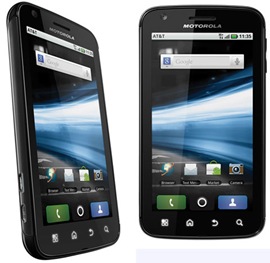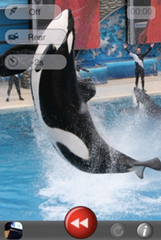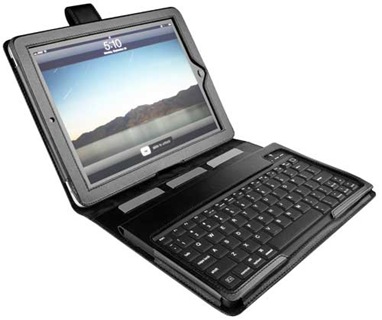Check out our Motorola Atrix 4G review inside. Is AT&T's new flagship the ultimate business smartphone?
 Motorola Atrix 4G Report
Motorola Atrix 4G Report
There are few phones that can contend with the Motorola Atrix 4G. It is a breed of its own. First off, this dual-core warrior is exceedingly versatile, courtesy of various accessories like Laptop, Multimedia, or Vehicle docks. Want to work from home using your work computer? That's what the laptop dock is for. Need a GPS unit in your car? That's what the Vehicle dock is for. Streaming 720p HD videos to HDTVs? The Multimedia dock. But then let's take a look at what's under the hood. A gig of RAM, 16GB of NAND flash, 5-megapixel camera with 720p HD video recording, and a whopping 1930mAh battery pack that churned out the best battery life we've seen on a smartphone to date. Yes, the Motorola Atrix 4G (specs) is a worthy adversary of the iPhone 4 and HTC Inspire 4G.
Design
Given our penchant for motorcycles, certain materials like titanium, stainless steel, and carbon fiber really light our Bunsen burners. Well, it happens to sport a back panel with a faux carbon fiber pattern, and that sold us on the spot. Not only does the phone look slicker than snail snot, but it's almost identical in size to the iPhone 4. Although it is slightly wider, we really didn't notice it while it hid out in our pocket. Besides, the phone's larger 4-inch qHD touchscreen was worth the miniscule width boost compared to the iPhone 4's 3.5-incher. Want to talk graphics? The Atrix 4G's screen is right up there with Apple's Retina display.
You'll also notice that this smartphone mounts its HDMI and USB terminals within close proximity of each other, and that's because they serve as the terminals for dock connections. Also, we weren't fans of the Power/Lock button at first, due to its recessed and hard to reach design. However, we quickly realized the benefit to this architectural divergence, and did not inadvertently toggle the phone while it sat in our pocket. A few other highlights are the Atrix 4G's front-facing VGA camera, four haptic feedback buttons consisting of Menu, Home, Back, and Search, and its 16GB of built-in NAND flash with supplemental MicroSD card slot. Obviously, the phone's 1930mAh battery and 5-megapixel camera with dual LED flash stole the show when it came to performance.
Software and Interface
Like so many Android devices in this current state of time, the Atrix 4G runs Android 2.2, which specializes in the full Google spectrum with Flash 10.1 support for the browser. But when we look at the phone's interface, that's a different story. The big player seems to be HTC Sense these days, but the Atrix 4G, being a Motorola phone, runs MOTOBLUR. MOTOBLUR is more of an acquired taste, as it specializes in social networking and the conjoining of various accounts into one centralized mass. MOTOBLUR is not as refined as iOS 4 or HTC Sense, but it's universal enough to appeal to a broad spectrum of users. The phone is fast with its NVIDIA Tegra 2 dual core processor (1GHz at each core) and 1GB of RAM.
With that said, the phone has 7 Home screens with the ability to add Motorola Widgets, Android Widgets, Shortcuts, Folders, or Wallpapers with a prolonged press and hold on any screen. We have the classic Android dropdown menu and a vertically-scrolling Applications menu that is easily accessed via the circular button wedged between the large Phone and Contact buttons. The neat thing about MOTOBLUR is that once you sign up, it will remotely save your settings. For instance, we were able to retain all of our signed in accounts just by signing in once to our MOTOBLUR account, so that was a plus.
Internet
The Motorola Atrix 4G is blessed with one of the better browsers out there. It's not as sleek as the HTC Sense browser, but it's quick and smooth. We get pinch-to-zoom and double-tap-to-zoom with text wrapping, and response time is great. Also, Flash 10.1 support allowed us to watch our YouTube reviews right from within the browser, lag-free. The phone comes with Vlingo, which is a speech-based phone search application that enabled us to search anything online or send emails via voice. We tested Vlingo, and it worked very well. Overall, the phone's HSPA+ speeds were well up to snuff, and Wi-Fi connectivity enhanced our browsing even further.
Multimedia and Productivity
With Quickoffice right out of the box, the Atrix 4G allowed us to work on Microsoft Office documents via the exceptionally welcoming keyboard. We were able to fly through sentences on Motorola's keyboard, and it heightened our level of productivity significantly. Thanks to our MOTOBLUR experience, the Atrix 4G offered a Universal Inbox, which combined all of our emails, messages, and other correspondence from various accounts like Gmail, Facebook, MySpace, and Twitter. This had a tendency to be overbearing, but our Account synchronization was flexible. The Atrix 4G also proved itself as a solid multimedia phone, handling 3D games with ease, thanks to its accelerometer and tasty dual-core action. The phone offers DLNA for streaming content onto other wireless devices and Media Share, which aided In the transferring of files to other devices.
Call Quality/Battery Life
Battery life is one of the Atrix 4G's primary strengths, as its 1930mAh rechargeable lithium ion battery pack cranked out the best smartphone longevity performance we've ever seen. This could not just be attributed to the phone's larger battery pack, but also its power management. There are three flavors to choose from: Maximum Battery Saver, which stops syncing data after 15 minutes of inactivity and dims the display. Then Nighttime Saver functions the same, only it allows full syncing throughout the day. Performance Mode is obviously geared for the minute-to-minute syncer, and uses the most battery power. However, we used Maximum Battery Saver and our Motorola Atrix 4G review unit lasted for days on standby. Holy moly. Yes, this phone is a marvel of battery craftsmanship.
That being said, voice quality paled in comparison. It was decent enough, but with connectivity to a nearby AT&T tower, we have heard better. That's not to say the Atrix 4G did not perform well�calls were perfectly acceptable. However, it could not match the noise-canceling goodness of the HTC Droid Incredible 2.
Accessories
Now let's talk accessories. No other phone on the market is compatible with the level of device-specific accessories that are available for the Atrix 4G. We were sent the Laptop dock and Multimedia Dock. We'll start with the Laptop Dock, which operates by plugging it into the USB and HDMI prongs located behind the display. We could view and control all action on the phone via Mobile View, which was represented in an individual window, or we could pop over to Firefox or Facebook for full browser-like experiences.
There was also a File Manager for easier control of our phone files and we could make calls through the phone in a skype fashion usin an on-screen dialer. For media, we got Motorola's Entertainment Center, which combined all of our images, videos, and music into one snazzy interface with the support of HD. Add in the fact that we could use Citrix to work remotely from the office�ideal for "sick days"�and the Laptop Dock was probably the most useful accessory. Oh, and don't forget the Bluetooth keyboard and mouse that Motorola sent us either.
We were also shipped a Multimedia Dock, which came equipped with three USB terminals, an HDMI port, and other clutch forms of connectivity. With the Multimedia Dock, we found it was best to set it next to an HDTV and hook the Atrix 4G up for 720p action, though we did not feel that the Multimedia Dock was a necessity, or as functional as the Laptop Dock. Then there was the Vehicle Dock, which transformed the Atrix 4G into a car GPS. This was a bit more useful, and we're sure Garmin must be very angry.
Camera
The phone has a 5-megapixel camera with dual LED flash and 720p HD video recording. We tested the Atrix 4G against the T-Mobile G2x, and the G2x blew it away. That's not to say that the Atrix did not crank out a decent image performance. Bright light was good, and the phone had a modest amount of manual controls, Scene modes, and effects. Unfortunately, the Atrix 4G lacked touch focus and we could not toggle the video light on or off while recording. Also, low light sensitivity lacked significantly, especially when compared to the awesome power of the G2x's 8-megapixel sensor. The bottom line was that the Atrix 4G's camera was sufficient enough for most users, but those looking for a camera as the primary feature in a phone will want to check out the T-Mobile G2x or iPhone 4.
Motorola Atrix 4G � infoSync Diagnosis
This phone is an example of innovative thinking brought to the forefront of modern smartphone technology. We have a dual-core demon with 1GHz of RAM, fantastic battery life, and compatibility with accessories out the wazoo. The Atrix 4G will make working from home a breeze, thanks to the Laptop Dock, and can navigate your car wherever it needs to go, courtesy of the Vehicle Dock.
We are typically weary of phones that are compatible with a multitude of device-specific accessories, but the Atrix 4G proved itself as a worthy candidate. Though the phone could use a little boost in voice quality and camera quality, its overall package did not cease to impress us.
If you're looking for a great iPhone alternative, the Motorola Atrix 4G should be the first stop on your map, followed by the HTC Inspire 4G. Motorola really hit a home run with this phone, and we can't wait to see the follow-up to this model.
Infosync
 At the end of the Asus press conference at Computex 2011, Chairman Jonney Shih waited until the very last minute to unveil the best product of the night: The Asus PadFone, a convergent device that docks a smartphone into the back of a slate so that they can be used together as a single device. Problem is, the entire demonstration was based on a few concept videos and a prototype that was clearly unfinished. Still, it's a usage model that we were really excited about when the Motorola Atrix made its debut and an incredibly neat approach to mobile computing�if and when Asus decides to make it available to the public.
At the end of the Asus press conference at Computex 2011, Chairman Jonney Shih waited until the very last minute to unveil the best product of the night: The Asus PadFone, a convergent device that docks a smartphone into the back of a slate so that they can be used together as a single device. Problem is, the entire demonstration was based on a few concept videos and a prototype that was clearly unfinished. Still, it's a usage model that we were really excited about when the Motorola Atrix made its debut and an incredibly neat approach to mobile computing�if and when Asus decides to make it available to the public. 

































